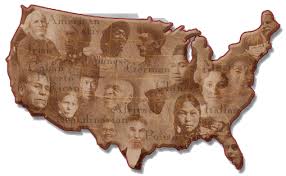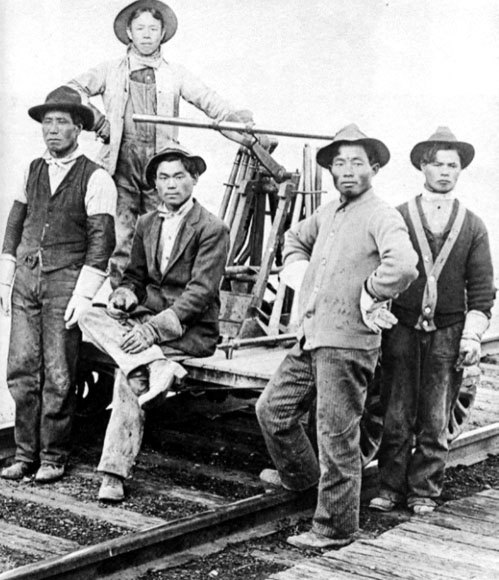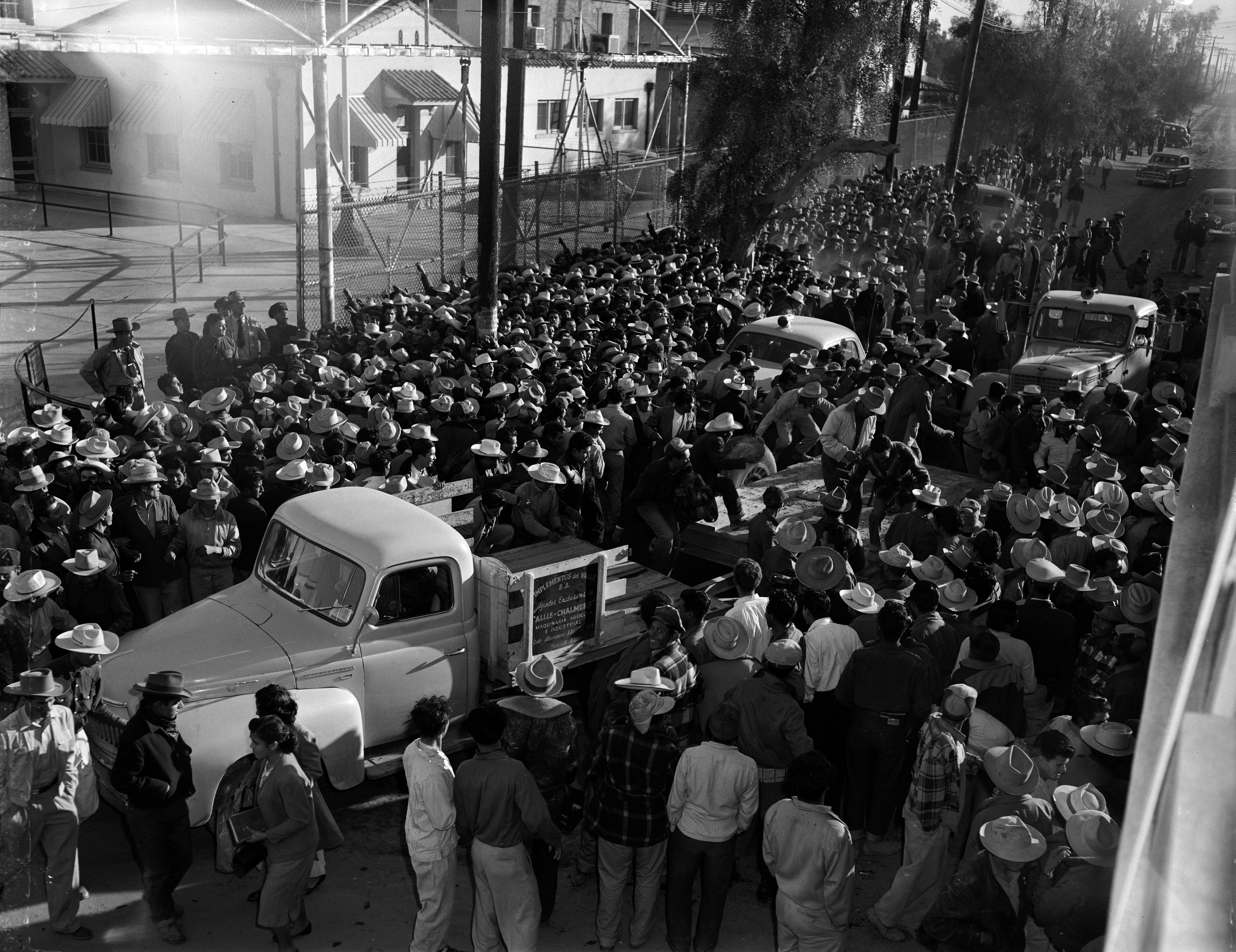United States: Shaped by Immigration
By: Michael Jocz

(http://latinosatdartmouth.wordpress.com/author/amarisdlr/page/7/)
The United States has a long history of being metaphorically known as a melting pot, a country where people of all different cultures can come together to create one nation. Although the United States has this history of allowing immigrants into the country and enabling them to live out the “American Dream”, a notion of making a better life by putting in hard work, the truth may be that the US actually has a history of discriminating against these immigrant “outsiders” and actually making it more difficult for them to make a living. It can be seen throughout the late nineteen and early twentieth centuries that a negative recurring pattern of immigration acceptance is established. This negative pattern, characterized with the Japanese and Mexican immigration periods, begins with a significant influx of immigrants that fill shortages in the American labor force. As the populations of these immigrants continued growing and the workforce became more saturated with immigrants, American citizens felt threatened by the heightened competition for scarce jobs and began to retaliate by discriminating against immigrants and started demanding legislation to protect them from foreign labor. These conflicts ultimately erupted in a major event that settles the tension between the immigrants and the Anglo-Americans. Fortunately, foreign immigrants continued to persevere against these discriminating practices and ultimately helped shape the United States into the country and culture that it is today, “The Land of Opportunity.”
To study the cycles of immigration, we will first look at how the various immigrant groups came to establish their influential presence in the United States. This will be followed by examining how tensions came to rise between the immigrants and the Anglo-Americans, the resulting discrimination that the immigrants faced, and conclude by reviewing the actions that resulted when these tensions reached their tipping point.
Japanese Immigrants
Significant Japanese immigration into the Unites States began around the 1880’s when Federal legislation was enacted restricting further Chinese immigration, thus creating a new demand for manual labor (Historical). The first generation of Japanese immigrants found employment building the transcontinental railroads and had a major role in helping to construct the Great Northern, Northern Pacific, Oregon Short Line and other railroads in the Columbia River Basin. In fact, by 1907, forty percent of Oregon’s total railroad labor force was comprised of Japanese immigrants. These immigrants not only provided cheap labor for the railroad companies, but were used to replace counter striking workers (Historical).

(http://lifenotes-tk.blogspot.com/2009_02_01_archive.html)
After working on the railroads, a number of Japanese immigrants started to own and operate their own farms as many had agricultural backgrounds prior to emigrating from Japan. Similarly, other Japanese immigrants started businesses or found work in the sugar beet production. Ultimately, these immigrants established communities along the west coast in which they were able to embrace their common culture (Historical). However, as the Japanese immigrant population increased, so did tensions from Anglo-Americans. Anglo-Americans soon began to have increasing anti-Japanese attitudes, as they had exhibited previously with the Chinese, as they had to compete against them in the workforce. Although Japanese immigrants never consisted of more than a small portion of the U.S. population, they were targeted by discrimination and anger by Anglo-Americans.
“However, by the early years of the century, organized campaigns had already arisen to exclude Japanese immigrants from U.S. life. Sensational reports appeared in the English-language press portraying the Japanese as the enemies of the American worker, as a menace to American womanhood, and as corrupting agents in American society” (Japanese).
This negative attitude towards Japanese immigrants continued to strain both cultures and governments. On October 11th, 1906, the San Francisco School Board arranged for Asian children to be placed in a segregated school (Gentlemen's). This outraged the Japanese government and people, prompting both the American and Japanese governments to enact the “Gentlemen’s Agreement” and the state of California’s Alien Land Law. The “Gentlemen’s Agreement” drastically limited further Japanese immigration into the United States. In return, the United States agreed to “granted admission to the wives, children, and other relatives of immigrants already resident” (Japanese). By restricting the future number of Japanese immigrants, similar to that done with Chinese immigrants previously, it was hoped that this action would alleviate non-immigrate tension by providing a better opportunity to find jobs that would have otherwise been filled by cheaper, foreign. Five years later, California passed the Alien Land Law which “barred all aliens ineligible for citizenship, and therefore all Asian immigrants, from owning land in California, even land they had purchased years before” (Japanese). The Alien Land Law was intended to further protected Anglo-American farmers in the west from having to compete with the Japanese immigrant farmers. It did not take long, though, for the Japanese immigrants to exploit a loop hole in the Alien Land law by transferring their land ownership into the names of their natural born citizen children.
The increasing tension between the Japanese immigrants and the Anglo-Americans literally exploded on December 7, 1941 with the Imperial Japanese Navy attack on Pearl Harbor. It was this military surprise attack and the resulting national emotions that prompted the United States to enter into World War II and to declare this a “date which will live in infamy”. President Franklin D. Roosevelt, deeming it necessary for self-defense and to prevent espionage in time of war, enacted Executive Order 9066. This Presidential order gave the US military authority to evacuate all Japanese individuals living within the proximity of essential US military facilities, regardless if they were American citizens or had ties back to Japan (Executive). This evacuation zone was a “fifty to sixty mile wide coastal area stretching from Washington State to California and extending inland into Southern Arizona” (Executive) and uprooted approximately 120,000 Japanese-Americans from the West Coast, deporting a majority of these individuals to internment camps.
Executive Order 9066 sent the clear and profound message that, although some of these Japanese immigrants may actually be US citizens, they are not “American”. The United States government, through the Office of War information’s advertisements, attempted to portray the Japanese internment as a “positive” opportunity, providing the opportunity to work the land as the pioneers of the American west had done, and in the process, become more “American”. The Secretary of War information also depicted the Japanese immigrants as happy to comply with the Presidential Order by fulfilling their civic duty. In reality, many Japanese individuals were forcibly uprooted from their homes and community even if they posed no threat to the US.

(http://www.loc.gov/pictures/resource/cph.3a35053/)
Mexican Immigrants
The increase in Mexican immigration to the Unites States, which immediately followed that of the Japanese, was the result of the need to backfill factory and farming jobs vacated by the World War II effort. The US and Mexican governments established an agreement, entitled the Bracero program, which was to be a temporary solution for the shortage of manual labor by importing workers from Mexico. The term Bracero, meaning day laborer, refers to the Mexican citizens or “nationals” brought to the United States under contract to aid in the harvesting of agricultural produce.
Luisa Moreno, author of “Caravans of Sorrow: Noncitizen Americans of the Southwest,” explored the issues of Mexican immigration and citizenship. Moreno wanted to make certain that US policymakers understood the history behind the expansion into New Mexico, Texas, and California where the greater percentage of first settlers into these regions were brought over from Mexico by the fruit exchange, railroad companies, and cotton industries (Moreno 120). These immigrant workers helped build the region and its economy, alongside citizens and noncitizens alike, and yet they were being driven, voluntarily or forcibly, from the area once the unemployment caused distress in the Anglo-American citizens.
The El Congreso del Pueblo de Habla Española (The Spanish-Speaking People’s Congress) attempted to bring Spanish speakers together by developing legislation encouraging naturalization, which would hopefully diminish discrimination in unequal wages, opportunities, and schooling. There was also an attempt to address the policies restricting Mexicans from using public places in certain towns in Texas, California, Colorado, and other Southwestern states. Many obstacles impeded the process of addressing his discrimination, especially the lack of documented proof of entry for the immigrants. Since Mexican entry into the United States was often not recorded or because the immigrants were brought over in large masses, like through the FSA Bracero program, documented proof of entry was not always available for those seeking naturalization. Another obstacle was the high naturalization fees which hindered many poor immigrant families from applying for naturalization (Moreno 121). For example, a Mexican family living on relief in Colorado would have to “stop eating for two and a half months to pay for the citizenship papers for one member of the family” (Moreno 122), thus making citizenship far beyond the reach of many Mexican families living in the United States.
The Bracero program increased tensions between the imported Mexican labor and the existing Anglo-American labor force. Agricultural companies preferred to import their workers from Mexico rather than hire the locals, even after World War II was over and the shortage of American workers was over. Tensions further increased when large scale farm operators would undermine, or bust, work union strikes by looking to imported labor to meet their demand (Cornell). These unions started demanding that the Bracero program be terminated as they were unable to improve their workers’ rights and wages due to the importing of immigrant labor.

(http://en.wikipedia.org/wiki/File:MexicaliBraceros,1954.jpg)
In the 1940’s, a Hispanic subculture was also developing within the United States known as the pachuco and was personified by a “style and behavior as a way to challenge ideas of respectability and to assert distinctive identity” (Escobedo 134). Imitating the gangster subculture of the 1920’s, the pachucos were characterized as young Mexican-American men, rebellious, flamboyant, associated with street gangs, and were easily identified by their zoot suit attire. Similarly, the pachucas were the Mexican-American young women who also rebelled against the social norms and created a new identity for themselves, similar to their men counterparts, wearing extravagant evening attire or men’s pants. The Anglo-American viewed the pachucas as a promiscuous woman that was also affiliated with gang members and challenged gender norms. Together, Anglo-Americans stereotyped these young Mexican-American youth as “a cultural pathology, a condition intrinsic to distinctive Mexican family patterns” (Escobedo 135). Before long, the media inaccurately depicted all Mexican youth “as dangerous hoodlums” (Escobedo 134).

(http://research.pomona.edu/zootsuit/en/zoot-suit-la/)
Engagement in World War II drove the necessity for all Americans to sacrifice for the greater good of the country and of a common culture, a view of a “nationhood that touted the importance of the unity of all races and creeds” (Escobedo 135). Americans were asked to ration nearly all types of supplies, join efforts with other community members to support families with military servicemen overseas, and to be unified under One Nation. All societal efforts and focus were geared towards the support the war effort. As a nation in war, the idea of individualism was foreign. These ideas about American identity were outwardly challenged by the pachuco/a as they lived a more self-indulgent lifestyle and drew attention on the individual during a time that called for self-sacrifice and collectively working for the betterment of society (Escobedo 135). A visible symbol of this disregard for the American identity was seen in the “zoot suits” themselves, clothing often made from large amounts of wool. It is important to realize that during this time, wool was highly rationed for the war effort. American citizens, upon seeing this flaunted disregard for support of the war effort and societal values, concluded two things: (1) only criminals could afford these materials, and (2) “zoot suiters” were anti-American (Escobedo 156). These negative perceptions led to difficulties for all Mexican-Americans in getting fair justice within the justice system and to a cultural tension between “zoot suiters” and Anglo-Americans. American servicemen were especially angered by “zoot suiters” as they viewed these young individuals as having the freedoms and opportunities of an American citizen, flaunting their perceived wealth which was obtained through criminal activities, and not supporting the servicemen or war effort which has granted them these privileges (Escobedo 156).
The pachuca were viewed differently from the established, older Mexican-American perspective, as they tested the gender roles of women as “social roles broadened more generally in the wartime environment” as women filled the voids left by the enlisted men. The challenging of these ideas led to a source of Mexican-American anxiety. As their young women, pachuca, gained more independence and were taking advantage of this independence, it was feared that they would not be able to return back to their original cultural roles once war was over. Mexican-Americans viewed the pachuca as the young women rebelling against the “good daughter” norms and blamed this rebellion from their own cultural priorities to the Americanization of their youth. This conflict of ideas created additional cultural tension between the Anglo- and Mexican-Americans. Before long, tension was created between the Mexican people and the American people as the rebellious young women celebrated the individual as the rest of the nation was working toward a united culture in the face of war and the imported labor was seen as taking away domestic jobs away from the American worker. Therefore, the Mexican people were often discriminated against and seen as outsiders by the Americans because of the rebellious youth and the imported manual labor during World War 2.
Conclusion
As a nation, the United States was discovered and formed by immigrants. These first immigrants journeyed from Europe and were seeking a different way of life, one where there was no discrimination in the practice of religion. Because of the way the United States was founded, it proudly was nicknamed “the melting pot”, a country and culture where different nationalities could reside as one. Ironically, then, are the periods throughout the American history where acceptance of immigrants has been met with discrimination and violence. Following on the heels of the discriminatory actions against the Chinese in the late 1800s, the Japanese immigrants began settling in the western United States and were able to find work in helping to build the continental railroad. This completion of this railroad was a monumental accomplishment that helped connect the eastern and western regions of the country and allowed for a transcontinental nation. The Mexican immigrants came to the States in numbers through the Bracero Program to help fill agricultural jobs during World War II. The Mexican workers helped keep the economy going in a time of war where replacement laborers were greatly needed. However, despite their notable contributions to the United States, both the Mexican and Japanese immigrants were still seen as “outsiders.” Although the United States may been known today as the “Land of Opportunity” for foreign immigrants, the Mexican and Japanese immigrants have had a very different experience. As each of the immigrant populations increased, they were subjected to harsh discriminations as the Anglo-Americans feared the competition in the work place. Despite being sent to military enforced internment camps or engaging in riots with US servicemen, these immigrants continued to persevere and, in doing so, had a hand in making the United States the country that it is today. How ironic that in the past ten years, US businesses have once again farmed out their labor to Asia and Mexico. However, rather than importing cheap labor through Asian and Mexican immigrants, US companies are now exporting their manufacturing locations to these same countries, thus continuing the Anglo-American tension with the loss of employment.
Works Cited:
"Alien Land Laws." Densho Encyclopedia. N.p.: n.p., n.d. Densho Encyclopedia. Web. 13 Dec.
2013.
Cornell, John. "Mexican Labor Vital Factor in Southland Agriculture." Los Angeles Times 27 Sept.
1948: n. pag. Print.
Escobedo, Elizabeth R. "The Pachuca Panic: Sexual and Cultural Battlegrounds in World War II
Los Angeles." The Western Historical Quarterly Summer 2007: 133-56. Print.
"Executive Order 9066: The President Authorizes Japanese Relocation." History Matters. N.p.,
n.d. Web. 13 Dec. 2013. <http://historymatters.gmu.edu/d/5154%20Test>.
"Gentlemen's Agreement." History. N.p., n.d. Web. 14 Dec. 2013. <http://www.history.com/
topics/gentlemens-agreement>.
"Historical Overview." Japanese Americans in the Columbia River Basin. N.p., n.d. Web. 13 Dec.
2013. <http://archive.vancouver.wsu.edu/crbeha/ja/ja.htm>.
"Japanese Immigration." Library of Congress. N.p., n.d. Web. 13 Dec. 2013.
<http://www.loc.gov/teachers/classroommaterials/presentationsandactivities/pr
sentations/immigration/japanese3.html>.
Moreno, Luisa. “Caravans of Sorrow: Noncitizen Americans of the Southwest” (1940)
U.S. Office of War Information, prod. Japanese Relocation (ca. 1943). Internet Archive. N.p., n.d.
Web. 14 Dec. 2013. <https://archive.org/details/Japanese1943>.
Kenneth Johnson Kenneth Johnson Jacob Stegemann Kristian Mateus Jacob Stegemann Kenneth Johnson
Comments (0)
You don't have permission to comment on this page.